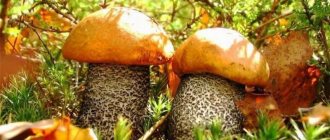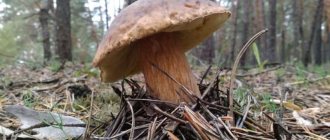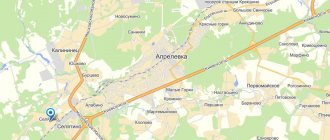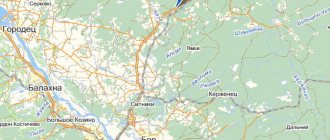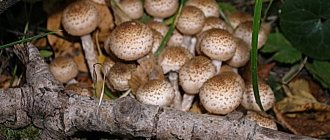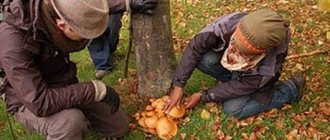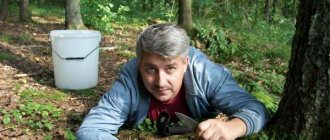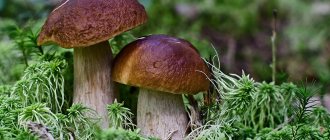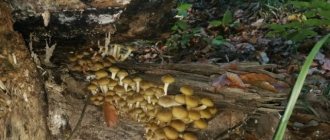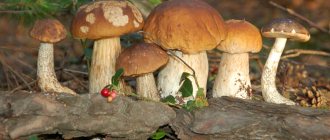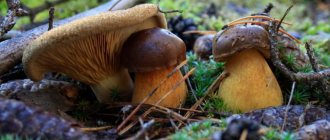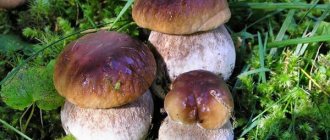The forests of the Republic of Chuvashia are literally teeming with mushrooms of all kinds and types. Moss mushrooms, milk mushrooms, boletus, boletus, boletus mushrooms, saffron milk mushrooms, honey mushrooms, chanterelles - and this is not the whole list. The past year allowed local residents to stock up on honey mushrooms, which grew everywhere and in large quantities. There were also plenty of boletus and boletus, and boletus probably set a record for the presence of growing places in one season. Mushroom places in Chuvashia are not only a supply of delicious food for the winter, but also a real gift for those who like to wander through the forest, as if traveling in a magical land. A carpet of soft moss and bright yellow foliage, the crackling of twigs and forest rustles, the cool smell of trees and earth - all this makes you come back here many times.
Beneficial features
Besides the wonderful hobby they represent, mushrooms are a valuable food product that grows in accessible places. The nutritional values far exceed some vegetables and are almost identical to meat. The ingredients contain enzymes and enzymes. They stimulate the appetite and contain sugar, mineral salt, fats, vitamins, carbohydrates and proteins.
Mushroom places in Chuvashia provide an opportunity to collect not just tasty food, but products with medicinal properties. For example, an edible specimen with the alarming name “dung beetle” can be used as a seasoning or as an independent dish. At the same time, it is actively used for folk medical and scientific purposes.
Poisonous
Even once edible mushrooms are poisonous if they become old and wormy. You can build a list of the most common poisonous species in Chuvashia. Each of them contains a toxic substance that is harmful to the human body, including death:
DEATH CAP
This mushroom is especially insidious and is found in almost all forests of Chuvashia. It also received the name “green fly agaric.” Has a thin long stem and an ovoid cap when young; greenish-white color.
Death cap.
MOUNTAIN (PLUSH) WEB
Found in various forests near oak trees; It has a bright orange or brownish color of a small cap and seventeen types of deadly toxic substances in its composition.
Mountain gossamer.
THIN PIG
Svinushka is identified by its short leg and olive-brown cap; it can be found in all regions of Chuvashia. Consumption of this type of poisonous mushroom can lead to severe kidney failure and subsequent death.
Thin pig
FIBER CURLED
A deadly poisonous mushroom that lives in coniferous and, less commonly, mixed forests. The brown or dark brown color of the cap and stem can help identify this mushroom. The composition, like that of the thin pig, contains the poison muscarine.
The fiber is similar.
GIANT STITCH AND ORDINARY STITCH
The giant one grows in rare birch forests or next to middle-aged birch trees, while the ordinary one grows in pine and mixed forests. They grow simultaneously during the period of late April-early June, outwardly they look like crumpled paper.
The line is gigantic.
ENTOLOMA POISONOS
Closing the list of toxic mushrooms is the poisonous entoloma, which lives in deciduous forests. The color of its cap varies from white to light brown. Not fatal, but can lead to stomach problems.
Entoloma is poisonous.
Correct search
Many inexperienced collectors complain that there are seasons and days when there are no mushroom places in Chuvashia. But old-timers who have walked many kilometers around the area know for sure that the object of their hobby is always there, they just need to look more carefully. Local residents always have information about several edges with boletuses, chanterelles or white ones.
In addition, people are well versed in the habits of wild animals and other forest inhabitants, including geographical preferences and preferences. Before heading into the forest, you need to determine which particular specimen is of interest today. A map of mushroom places in Chuvashia will be a good helper. You can be guided by these documents, but it is better to trust the stories of local people and hit the road, following the advice of experienced people. Finding many mushrooms is not difficult. Following the names, it is easy to figure out where and what grows: boletus in a birch grove, aspen boletus in an aspen grove, and white oak in an oak grove. In the forest you can collect russula, saffron milk caps and boletus. But the most popular are mixed forests. Here you can find almost any species common in the region.
Common edible species
Along with the onset of warm weather, numerous edible fruiting bodies begin to actively grow in the forests of the Chuvash region. When going on a “quiet hunt,” every mushroom picker can be sure that he will not return home empty-handed.
Boletus
Experienced mushroom pickers recommend that you hurry up and collect boletus mushrooms while they are still young. These are the fruits that are the most delicious and healthy. At a young age they have a spherical cap. After a few days it becomes prostrate, looking like a plate. The average circumference of the cap section is 15 cm.
The leg is very dense, thick and stocky, and there are numerous black scales on its surface. When cut, the pulp acquires a pink-violet or gray-violet color.
boletus
Boletus is a delicious mushroom, a source of vitamins and microelements. The color of the cap can be described as muted brown. The diameter is about 12 cm.
The leg, unlike the boletus, is not too dense. However, on its surface there are also small, numerous black scales. The pulp does not have a distinct odor, but its taste is pleasant and turns pinkish when cut.
On a note!
The most optimal time for collecting boletus mushrooms is the period after good rains. These fruits love moist soil, so after rainfall they begin to grow with double intensity.
Russula
The bright color of this fruit will not allow the mushroom picker to pass by indifferently. But not only this is a plus, since the mushroom is also incredibly tasty, which is why it is very popular among gourmets. But it is worth noting that in the official literature this species is considered conditionally edible.
The mushroom cap has a diameter of 3.5 to 10 cm, at first it is convex, after which it becomes flattened, depressed, and funnel-shaped. Its skin is matte, and in dry weather it sometimes becomes velvety. The leg reaches 5-8 cm in height and 1-2 cm in thickness.
The pulp is white, quite strong. When exposed to air, it turns brown or yellow. Young mushrooms have a very weak odor, but after drying it acquires a shrimp-like hue.
Russula forms mycorrhiza with coniferous trees - pine and spruce. Grows singly or in small families.
Volnushki
Volnushka grows from June to October, mainly under birch trees. Grows in mixed or pure birch forests.
The cap of the fetus grows to 4-12 cm in circumference. At first it is convex, but then becomes denser. There is a depression on its surface, and in the center and closer to the edges there are wavy circles. It is by this feature that one can distinguish pink mushroom from other similar mushrooms.
Butter
The real oiler is a mushroom of the genus Oiler. The main parameters by which the fetus can be recognized are as follows:
- Hat. Small, with a diameter of 3 to 14 cm, hemispherical in shape, but then becomes round-convex, plano-convex or cushion-shaped. Sometimes completely flat. Its surface is smooth and slimy, and after rain it becomes quite convex. The color may vary - brown, chocolate brown, dark orange, etc.
- Pulp. Soft and juicy. The color is whitish or yellowish.
- Leg. Height is from 3 to 10 cm, thickness - from 1 to 2.5 cm. Its color is whitish or yellowish. On the surface there is a ring, first white, then brownish, black-brown or dirty purple.
It is recommended to look for boletus in places where Scots pine or other double-leaved pines grow. They usually settle near young plantings.
White mushrooms
Boletus mushrooms, or porcini mushrooms, are quite massive and large fruits. The cap of especially large specimens reaches 25-30 cm in circumference. Light or dark brown in color. The leg is thick and dense - up to 7 cm, but sometimes reaches 10 cm or more. It reaches a height of 8-15 cm. The taste of the pulp is delicate, soft and quite pleasant.
Boletuses form mycorrhizae with different trees. They can be either deciduous or coniferous. But most often they can be found in the growing zone:
- oil;
- pine trees;
- oaks;
- birch
This is interesting!
Some relationship has been noted between the appearance of boletus and other types of mushrooms. For example, the boron form grows in the fall at the same time as the greenfinch, the oak form grows together with the green russula, and the birch form grows with chanterelles.
Chanterelles
You may be interested in: How do edible talkers differ from false mushrooms? How many days after rain do mushrooms grow? Bitter mushroom: photo and detailed description
The real chanterelle is an edible mushroom belonging to the genus Chanterelles. Grows from June to October. A distinctive feature of the chanterelle is its fruiting body. It represents a single whole, that is, there is no clear boundary between the cap and the stem. The color of the mushroom varies from light yellow to orange-yellow.
The diameter of the cap is 3-12 cm. Its edges are wavy or have an irregular shape. The skin is difficult to separate from the pulp, which is characterized by density and fleshiness. The leg of chanterelles is fibrous, the same color as the cap. Its height is 4-7 cm, and its thickness is 1-3 cm.
It is best to look for chanterelles in places where there are large concentrations of beeches, oaks, pines and spruces.
Milk mushrooms
On the territory of the Chuvash region, it is black milk mushrooms that are widespread, and not the usual white milk mushrooms. Main characteristics of the fruit:
- Hat. The shape is flat, with a small but noticeable depression visible in the center. Its diameter is 7-20 cm. The skin has a dark olive color. In humid weather it becomes sticky and sticky.
- Pulp. Its structure can be called dense, but at the same time brittle. The color of the flesh is white, but when cut it becomes grayish and begins to secrete abundant milky juice.
- Leg. Its height is 3-8 cm, and its thickness is 1.5-3 cm. The surface is mucous and smooth. The leg itself is narrowed downwards. Usually its color matches the color of the cap, but it can be lighter.
Black milk mushrooms form mycorrhiza mainly with birch. Distribution area: mixed forests and birch forests. Usually grows in large groups.
Honey mushrooms
Even amateur mushroom pickers can recognize these small mushrooms. The fruits grow on stumps, mainly in the form of a ring, which is why they got their Latin name Armillaria, which translates as “bracelet”.
The shade of the cap of the honey mushroom can be different - cream, yellowish or reddish. The leg is quite long - 12-15 cm in height. Its color can be light honey or dark brown - it all depends on where the mushroom grows and its age.
On the surface of the leg there is a “skirt”, above which there is a plate-like cap noticeably curved downwards. In young specimens it has a hemispherical shape, and its surface is covered with numerous small scales.
Interesting!
Honey fungus grows not only on living trees. Often it covers stumps that remain from cutting down old or diseased plantings.
Conditions for growth
The best circumstances for appearance are warm but damp weather. Therefore, the optimal time to go to the forest is a few days after heavy rain or thunderstorms. Those who are accustomed to planning their trips to the forest belt study the service forecast in advance and are able to predict upcoming changes. Signs will also help, always telling you where mushrooms grow. Here are the most famous and widespread folk notes that warn of rainfall in the near future:
- Poor visibility of the starry sky at night.
- Clover bends towards the soil and closes its bud.
- There is no dew early in the morning.
- There is no wind, but the foliage is noisy.
- The aroma of plants is enhanced several times.
Are there any mushrooms now?
Online forums of avid mushroom pickers will always accurately answer this question. Now avid lovers of quiet hunting are saying one thing - farewell to the mushroom picking season has come. The next meeting will take place in 2022. However, do not despair, others write; it is quite possible to take a walk through the forest and find a few more porcini mushrooms or other members of the family.
Gathering Festival
The fair event, aimed at demonstrating that mushrooms in Chuvashia are a real asset, is regularly held in various national parks in the region, including near the regional center - the city of Cheboksary. In addition to the festive part, the organizers are preparing a short report on caring for the gifts of nature and energy resources. The most inquisitive can ask local residents where mushrooms grow, and the rest will have a very rich and interesting program. A literary exhibition, a quiz for adults and children, sweet gifts and surprises - all this can be seen at the festival. In addition, as part of the event, a musical concert is held and master classes on preparing and salting the product are given.
Places prohibited for gathering
It is worth noting that the republican authorities and specialized services warn people about responsibility for violating the laws. Many mushroom places in Chuvashia are located on the territory of nature reserves or forest reserves. For collecting food in these areas, the attacker will be fined in monetary terms, even if he did it unknowingly, not knowing that he was in a forbidden area.
The amount of the forced contribution will be from three to four thousand rubles, depending on the severity of the act and damage to the infrastructure, mycelium and the reserve as a whole. It is worth noting that there are organizations in the republic that allow tourists and travelers, including mushroom pickers, into their territory. This is done on specially designated days and is strictly regulated by the time period.
